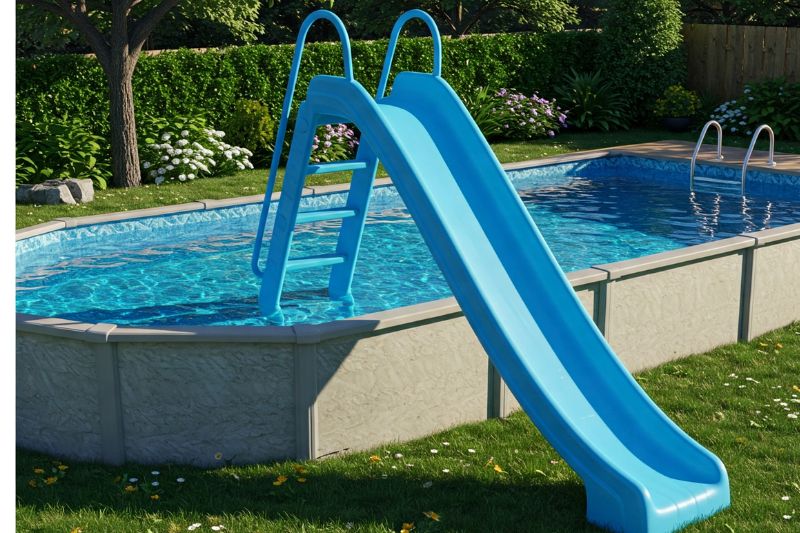
What Is The Best Material For A Pool Slide?
Share
When you’re building a pool slide, choosing the right material is essential. It directly affects the safety, longevity, and enjoyment of the slide. There are various materials to consider, each offering its own advantages. In this post, we’ll explore the best materials for pool slides and help you make the best decision for your backyard oasis.
Key Factors to Consider When Choosing a Pool Slide Material
Before diving into the materials, let’s discuss some of the main factors you should consider when choosing the best material for your pool slide.
-
Safety: The material should provide good traction and be resistant to slipping, as it directly impacts the safety of users.
-
Durability: Since pool slides are exposed to water, sunlight, and frequent use, durability is a key factor to keep in mind.
-
Maintenance: Some materials may require more maintenance than others. It’s important to choose something that’s easy to clean and maintain.
-
Aesthetics: The material should match the overall design and look of your pool area.
The Best Materials for Pool Slides
Now let’s look at some of the most popular materials for pool slides and what makes each one stand out.
1. Fiberglass
Fiberglass is one of the most common materials used for pool slides. It’s durable, smooth, and has a shiny surface that makes it appealing to many homeowners.
Advantages:
-
Durability: Fiberglass is resistant to cracking and weathering, making it ideal for long-lasting use.
-
Smoothness: The smooth surface of fiberglass provides a faster and more enjoyable slide.
-
Low Maintenance: It’s easy to clean and doesn’t require much upkeep.
-
Aesthetic Appeal: Fiberglass comes in a variety of colors and designs, which can be customized to suit the look of your pool area.
Disadvantages:
-
Cost: Fiberglass slides can be more expensive than some other materials.
-
Heavy: These slides can be heavy, which may make installation a bit more challenging.
2. Plastic (Polyethylene)
Plastic is another popular material for pool slides, and polyethylene is the most common type used. It’s a lighter, more affordable option compared to fiberglass.
Advantages:
-
Affordable: Plastic slides are generally less expensive than fiberglass slides.
-
Lightweight: Plastic slides are easy to install and move around if necessary.
-
Durability: While not as strong as fiberglass, high-quality polyethylene is still durable enough for most pool environments.
-
Variety of Colors: Plastic slides are available in a wide range of colors to suit your pool decor.
Disadvantages:
-
Not as Smooth: Plastic slides may not be as smooth as fiberglass, making the ride a bit slower.
-
Fading: Over time, plastic can fade due to sun exposure.
3. Stainless Steel
For a more modern and sleek look, stainless steel is a top-tier material for pool slides. Though not as common as fiberglass or plastic, it offers a luxurious appearance.
Advantages:
-
Durability: Stainless steel is incredibly durable and resistant to corrosion, making it ideal for poolside use.
-
Modern Aesthetic: Stainless steel gives a sophisticated, high-end look to your pool area.
-
Smooth Surface: The metal is naturally smooth, which provides a quick, thrilling ride.
Disadvantages:
-
High Cost: Stainless steel slides are typically the most expensive option.
-
Heat: Stainless steel can get very hot under the sun, making it uncomfortable to use during the summer.
4. Vinyl
Vinyl-coated slides are another option, although they aren’t as common as fiberglass or plastic. The vinyl coating is typically applied over a metal or plastic frame.
Advantages:
-
Smooth Ride: The vinyl coating ensures a smooth ride down the slide.
-
Easy to Clean: Vinyl is easy to wipe down and maintain.
-
Customizable: Vinyl-coated slides come in various colors and designs, giving you more flexibility for customization.
Disadvantages:
-
Durability: Over time, the vinyl coating can wear off, especially with heavy use.
-
Limited Availability: Not as many manufacturers produce vinyl-coated slides as compared to fiberglass or plastic slides.
How to Maintain Your Pool Slide
Once you’ve chosen the perfect material for your pool slide, it’s important to keep it well-maintained. Here are a few tips to keep your slide in top condition:
-
Clean Regularly: Always clean your slide after each use, especially if it’s exposed to chemicals, dirt, or algae.
-
Inspect for Damage: Regularly check for cracks, rust, or any signs of damage. Early detection can prevent bigger issues down the road.
-
Use a Protective Cover: If you’re not using the slide for an extended period, consider using a cover to protect it from the elements.
Choosing the best material for your pool slide depends on your budget, aesthetic preferences, and the features you prioritize. Fiberglass is durable and smooth, while plastic offers affordability. Stainless steel gives a modern look but comes with a high price tag, and vinyl offers a unique touch with its smooth ride and ease of maintenance. Consider all of these factors before making your final decision, and you’ll have a pool slide that enhances your pool experience for years to come.
